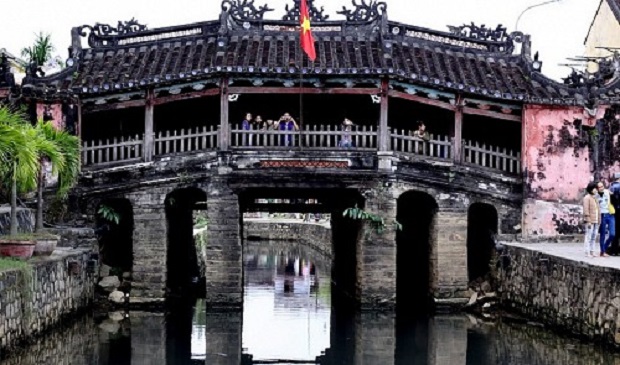Popular tourist bridge in Hoi An to bite dust in restoration's name
Vietnamese and Japanese experts have suggested that a symbolic bridge in Hoi An be deconstructed for restoration.
 |
|
The Japanese Covered Bridge in Hoi An. Tuoi Tre |
Nearly 120 scientists, experts, and project managers from Viet Nam and Japan have suggested pulling down the Japanese Covered Bridge during a recent international conference.
The bridge, which is Hoi An’s most distinctive attraction and a national heritage site, is facing serious degradation while having to welcome an average of 4,000 tourists on a daily basis.
Several of its abutments have become fractured while some piers are damaged by the flow of water underneath as well as by the wet environment.
Situated in the center of the city, the structure is also placed under risk whenever floods occur, posing threats to visitors and local residents.
The bridge requires prompt restoration, Professor Luu Tran Tieu, president of the Cultural Heritage Association of Viet Nam, said, adding that the architecture must be carefully documented and digitised before any demolition.
A comprehensive restoration plan must be established with a focus on respecting the imprint of time on the bridge and its heritage value, Prof. Tieu continued, asserting that modern technology must be applied.
According to Tomoda Hiromichi, a university professor from Japan, the attraction is a symbol of the Viet Nam-Japan traditional friendship.
Hiromichi considered his contribution to the renovation of the bridge an honor, confirming that Japanese experts would be invited to Hoi An to assess the condition and figure out the best possible measures to fix it.
Cutting-edge cameras should be used to capture specific details of the bridge’s design before a three-dimensional film is constructed, based on which the original architecture can be restored, the Japanese expert recommended.
Tran Dinh Thanh, deputy chief of the Department of Cultural Heritage, said that the demolition of such a famous construction as the bridge was common, before adding that careful progress is a must.
According to Le Van Thanh, vice-chairman of the People’s Committee in Quang Nam, which administers Hoi An, all delegates reached a consensus on dismantling the entire structure for restoration.
“However, consultation from local and international experts and the application of modern technology will be required to ensure the original design of the special bridge,” Thanh said.
It is expected that renovation work will be carried out from 2017 to 2020, the official added.
The bridge, locally referred to as the ‘Chua Cau’ or ‘Lai Vien Kieu,’ was constructed by the Japanese community in Hoi An in the 17th century and was recognised as the nation’s most historic and cultural relic in 1990.
Over nearly 400 years of existence, the structure has been renovated many times, with the most recent in 1986.
(Source: Tuoitrenews)